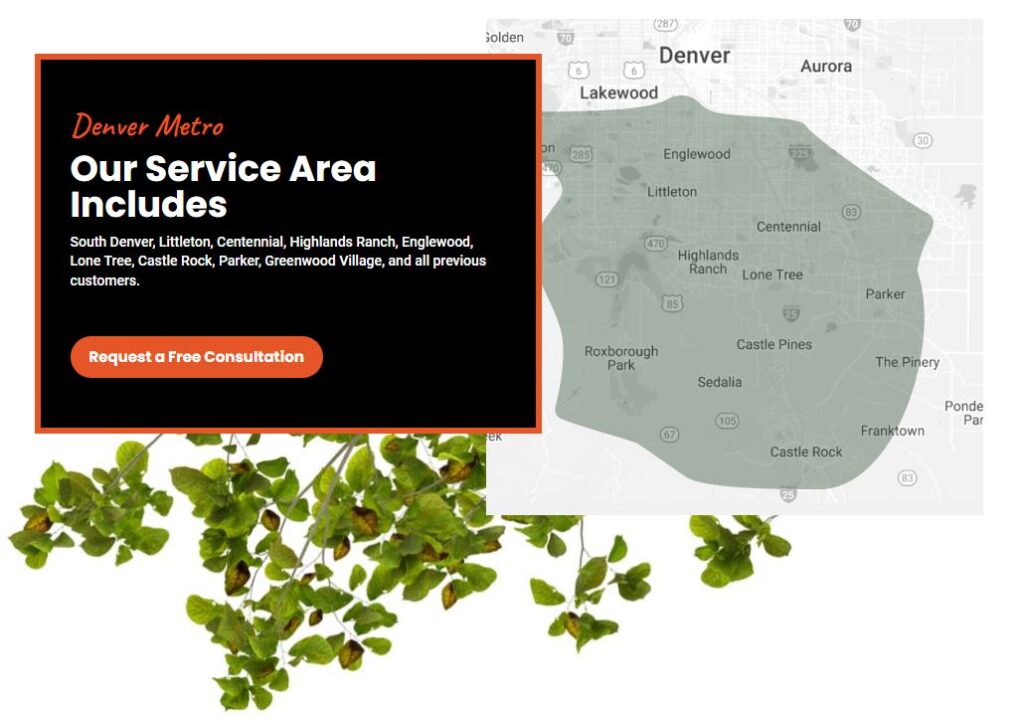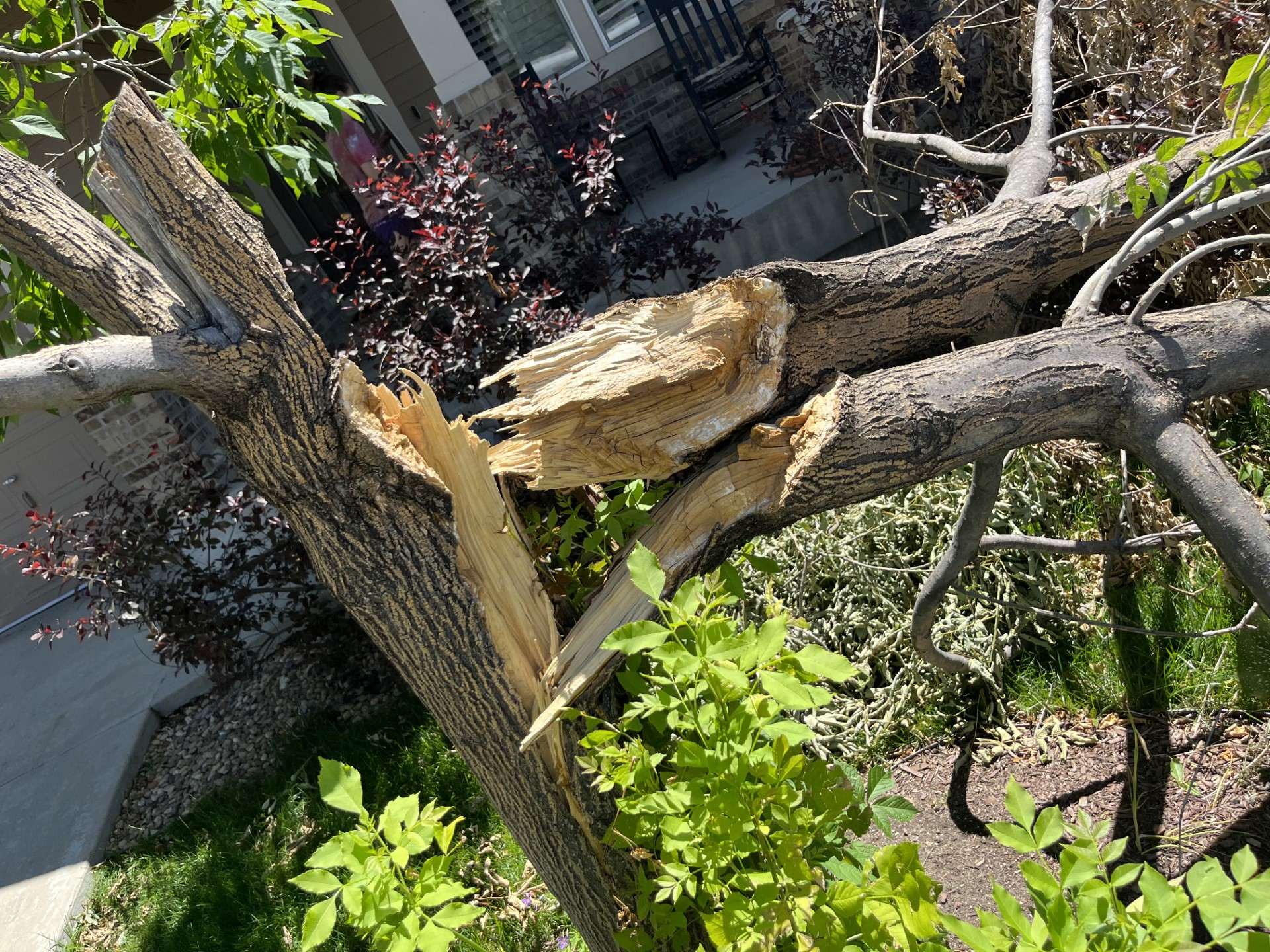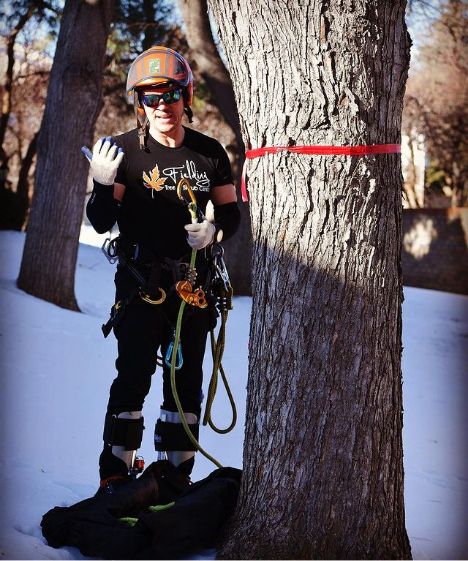Living in Denver, we’re accustomed to the impact of various types of storms that can wreak havoc on our trees. From sudden snowstorms to strong winds, brutal hail, and heavy rains, these natural occurrences can leave trees vulnerable to damage and disease. In this article, we’ll delve into the steps homeowners can take to aid their trees in recovering from last year’s late spring storm damage and provide tips on safeguarding against future storm-related issues, focusing on the Denver area.
Urgent Storm Damage on Your Property? Act Now!
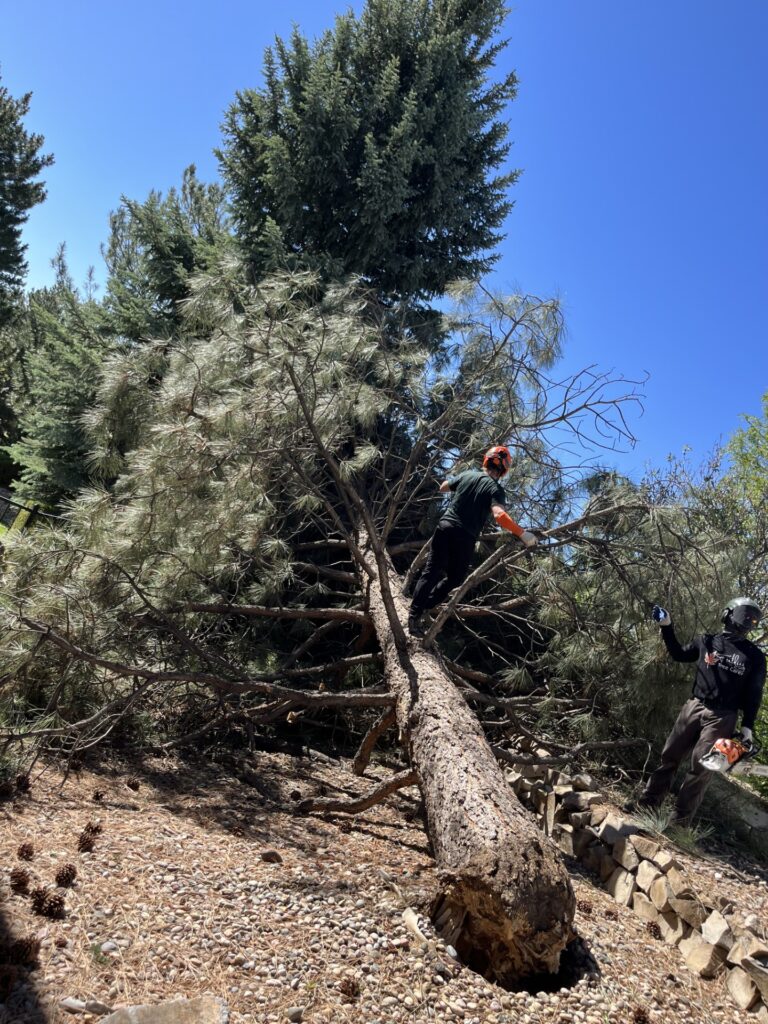 If you’re reading this article because your trees have recently endured storm damage, we understand the urgency you may feel. Storm damage isn’t just an inconvenience – it can be hazardous. Unstable branches, leaning trees, and uprooted trunks pose risks to your property and safety. Don’t wait until the next storm hits; take action now to safeguard your surroundings. You need an arborist that provides storm damage tree removal services!
If you’re reading this article because your trees have recently endured storm damage, we understand the urgency you may feel. Storm damage isn’t just an inconvenience – it can be hazardous. Unstable branches, leaning trees, and uprooted trunks pose risks to your property and safety. Don’t wait until the next storm hits; take action now to safeguard your surroundings. You need an arborist that provides storm damage tree removal services!
Fielding Tree Care is here to help. While we serve a much larger area in Colorado than just Denver, this article is specifically tailored to address Denver storm damage. Our certified arborists specialize in storm damage recovery and prevention, offering prompt assistance to address the immediate needs of your trees and property.
Don’t Wait – Your Trees Deserve Immediate Care
With Denver’s unpredictable weather, quick attention to storm damage is essential. Contact us without delay to schedule a consultation and ensure that your trees receive the attention they require.
To learn more about the services we provide and where we provide them, please visit the links below:
Damage After a Severe Seasonal Storm
Denver residents are no strangers to winter weather, but who could have anticipated that late May snowstorm in 2019? With an unexpected 10-20 inches of snow blanketing the city, power lines snap and trees suffered significant damage. During the storm, over 210,000 residents lost power due to the storm’s severity.
While this surely was an inconvenience for many residents, it was a disaster for the city’s trees. Many residents were unprepared and suffered damage to their homes and properties. So as an exercise in preparedness, here are the most common seasonal storms in Colorado.
Colorado experiences a variety of seasonal storms due to its diverse climate and geographical features. Here are some of the common types of seasonal storms that affect the state:
Winter Snowstorms
Winter snowstorms are a significant weather event in Colorado. These storms bring heavy snowfall and often result in blizzard conditions, which can lead to road closures, power outages, and transportation disruptions.
Spring Snowstorms
Spring snowstorms are not uncommon in Colorado, and they can be particularly disruptive as they occur during a time when the weather is transitioning to warmer conditions. Late spring snowstorms can bring unexpected heavy snowfall and affect trees and power lines.
Thunderstorms
Thunderstorms are prevalent during the spring and summer months in Colorado. These storms can bring lightning, heavy rain, hail, and strong winds. Severe thunderstorms may also lead to flash flooding, tornadoes, and hail damage.
Summer Monsoons
Colorado experiences a monsoon season during the summer, primarily in July and August. Monsoons bring heavy rainfall to the state, leading to an increased risk of flash floods and mudslides, particularly in burn scar areas.
Fall Snowstorms
Fall snowstorms are possible, especially in higher elevations. These storms can impact travel and outdoor activities, particularly in mountainous regions.
Dust Storms (Haboobs)
Dust storms, or haboobs, can occur in Colorado’s drier regions, especially in the eastern plains. These storms are characterized by strong winds carrying dust and sand, reducing visibility and creating hazardous driving conditions.
Cold Fronts
Rapid changes in temperature and weather conditions due to cold fronts are common in Colorado. These fronts can lead to sudden drops in temperature, strong winds, and even snowfall.
Wildfire-Related Weather
While not traditional storms, weather conditions play a significant role in the state’s wildfire activity. Dry and windy conditions can exacerbate wildfire risk, especially during the warmer months.
Hail Storms
Hail storms are a frequent occurrence in Colorado, particularly during thunderstorms. Hailstones of varying sizes can cause damage to vehicles, crops, and property, posing a significant threat to both rural and urban areas.
Bomb Cyclones
Bomb cyclones, also known as bombogenesis, are rapidly intensifying low-pressure systems that bring a rapid drop in atmospheric pressure and strong winds. These storms can result in blizzard conditions, heavy snowfall, and gusty winds, leading to transportation disruptions and power outages.
It’s important for Colorado residents to stay informed about local weather forecasts and to be prepared for a range of weather events throughout the year. This knowledge can help individuals take necessary precautions to protect their property and safety during different types of storms.
Assessing Storm Damage on Your Property
Understanding the potential risks associated with trees on your property can help you take proactive measures to maintain tree health, conduct regular inspections, and make informed decisions to prevent damage to your property. Below are some examples of the types of damage we often see after storms:
- Damage to Fences: Overgrown tree branches or falling trees can damage fences, leading to costly repairs.
- Cracked Pavements: Tree roots can exert pressure on pavements and sidewalks, causing cracks and uneven surfaces.
- Damage to Roofs: Overhanging tree limbs can be knocked down during storms, damaging your roof and even falling into your house.
- Blocked Gutters and Drainage: Falling leaves, branches, and debris from trees can clog gutters and disrupt drainage systems, leading to water damage and erosion.
- Blocked Driveways: Fallen trees across your driveway can impede access to your vehicles, necessitating prompt removal to restore functionality.
- Power Line Interference: Trees growing near power lines can cause disruptions and pose safety hazards if branches come into contact with live wires.
- Damage to Siding: Tree limbs can blow into your siding or repeatedly rub against your home, leading to scratching or deeper structural damage.
- Pest Infestations: Overgrown or unhealthy trees can attract pests, which may eventually spread to your property and home.
- Reduced Sunlight: Dense tree canopies can block sunlight, affecting the growth of grass, plants, and gardens in your yard.
- Fire Hazards: Dead or dry tree limbs can become fuel for fires, increasing the risk of fire spreading to nearby structures.
- Obstructed Views: Trees blocking scenic views or visibility of traffic signs can compromise safety and reduce property appeal.
- Structural Foundation Damage: Tree roots growing close to a property’s foundation can cause cracks and instability in the structure over time.
- Damage to Service Lines: Tree roots have the potential to grow into service lines, such as water or gas lines, resulting in damage and potential utility disruptions.
- Interior Water Damage: When a tree limb or an entire tree falls onto or against your house during a storm, rainwater can enter and cause interior water damage.
- Allergic Reactions: Pollen and other allergens from trees can cause allergic reactions for residents, affecting their comfort and health.
However, storm damage isn’t always immediately visible. Issues like holes, cracks in the trunk, splitting bark, and root system damage can also occur and go unnoticed. The initial step involves consulting a certified arborist to assess tree damage. These experts are trained to identify damage severity and recommend appropriate treatments or storm damage tree removal services.
Recovering from Storm Damage
In the aftermath of severe snowstorm damage, it’s essential to follow a comprehensive recovery plan for your trees’ long-term health. Homeowners in Denver can take these actions to aid their trees’ recovery:
Thorough Assessment
Inspect trees closely for damage. Broken branches, cracked bark, and leaning trees warrant professional attention.
Consult an Arborist
Certified arborists possess the expertise to diagnose damage and propose suitable action plans.
Strategize Recovery
Collaborate with the arborist to create a recovery plan, which may involve removing damaged branches, staking leaning trees, or mulching for root protection.
Implement the Plan
Execute the plan in consultation with the arborist. Patience is key as recovery can be a gradual process.
Addressing Existing Storm Damage
Trimming broken branches immediately reduces potential further harm to the tree and aids in recovery. For leaning trees, strategic staking is essential to prevent toppling. A broad, non-invasive strap is recommended to protect the bark. Staking encourages root growth, ultimately helping the tree stand independently.
Long-term recovery involves practices like deep watering, mulching, and fertilizing. These steps alleviate the stress caused by the snowstorm and resultant damage. Tree stress arises when a tree cannot generate sufficient energy for growth—a situation worsened by storm damage. While these methods are effective, patience is required, as complete recovery might take years.
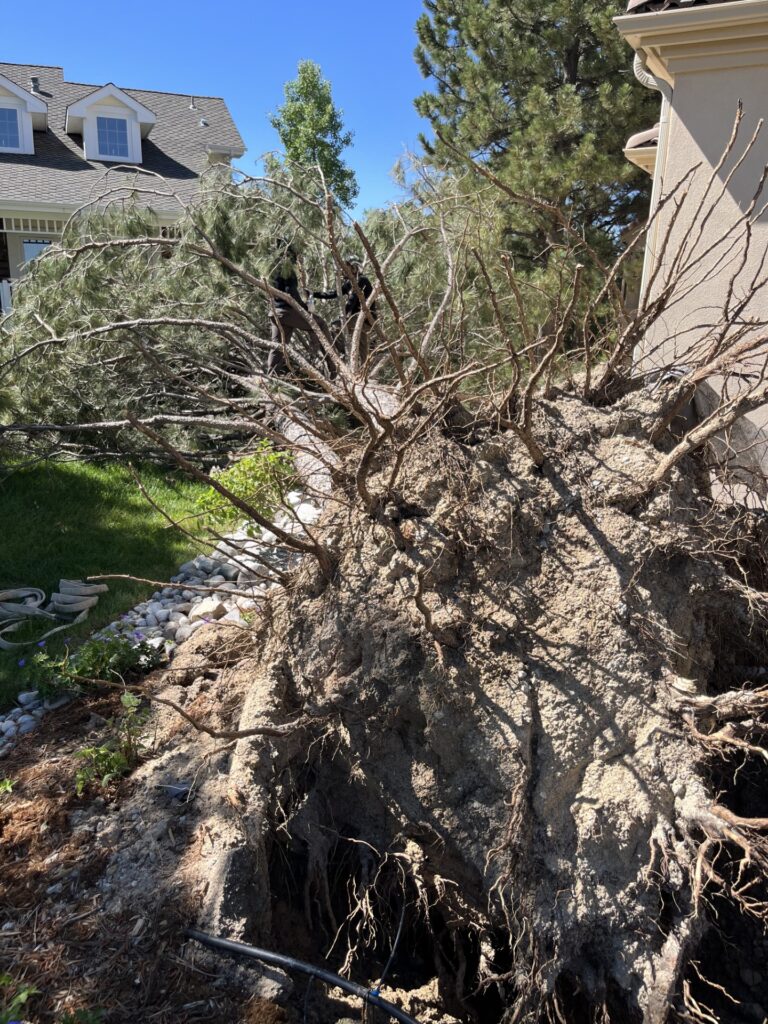 Unfortunately, many times storm damage tree removal services are necessary to protect you and your property. A certified arborist can safely remove any tree – and if your damaged tree rings true to that sentence, you should definitely check out our tree removal services because it’s probably at that stage.
Unfortunately, many times storm damage tree removal services are necessary to protect you and your property. A certified arborist can safely remove any tree – and if your damaged tree rings true to that sentence, you should definitely check out our tree removal services because it’s probably at that stage.
Preventing Future Storm Damage
Preventing storm damage is more efficient than addressing it afterward.
Denver’s susceptibility to various storms calls for proactive measures:
Regular Inspections
Regularly inspect trees for dead branches and unusual signs.
Pruning Routine
Consistent pruning eliminates dead branches prone to falling during storms.
Storm Support
In storm-prone areas, consider installing storm straps or cables to bolster trees against high winds.
Mulching for Root Protection
Mulching safeguards roots from extreme temperatures and conserves moisture.
Adequate Watering
Ensure trees receive sufficient water for enhanced resistance against storm damage.
Insurance Concerns Surrounding Storm Damage
Insurance Coverage for Peace of Mind
When hiring a certified arborist, ensuring proper insurance coverage is crucial. In fact, we welcome you to ask for current certificates of liability and workman’s compensation insurance to verify their validity. Our team of certified arborists at Fielding Tree Care in Denver is fully bonded, licensed, and insured, offering you peace of mind. This coverage alleviates your liability for any damages or injuries during our work, which can be especially concerning when dealing with storm damage.
Homeowner’s Insurance and Tree Removal
While Fielding Tree Care is no expert on homeowner’s insurance, our experience has provided us with insights into the factors that determine whether your homeowner’s insurance will pay for tree removal. There are many variables at play in these situations. What it comes down to is this: To properly assess the damage to your trees and/or property, it’s vital to contact your insurance claims adjuster. They will be able to determine which trees, if any, are covered for removal or other services by your homeowner’s insurance.
One great resource we recommend is the section of the City of Denver’s website that outlines what damage and debris property owners are responsible for. Additionally, it provides tips for removing broken tree limbs, addressing downed trees, and calling about downed power lines.
CONCLUSION
At Fielding Tree Care, we’re dedicated to safeguarding Denver’s trees from the impacts of storms. Our team specializes in storm damage prevention, recovery, and overall tree health, catering to homeowners throughout the Denver, CO area. With a deep understanding of Denver’s unique climate and the various storms that can occur year-round, we’re well-equipped to help your trees recover and thrive.
Our commitment to quality and expertise sets us apart. We continuously learn and stay updated with the latest practices and techniques in tree care. By choosing Fielding Tree Care, you can be confident that your trees are in the hands of skilled professionals who are dedicated to delivering exceptional results.
If you’ve experienced storm damage or are concerned about the well-being of your trees after a severe weather event, don’t hesitate to reach out to us. Our certified arborists are here to provide you with the information and guidance you need to ensure the health and vitality of your trees. From assessing storm damage to creating tailored recovery plans, we’re by your side, every step of the way.
Remember, our team offers not only storm damage tree care services but also a comprehensive range of tree care solutions in various cities across Denver. We invite you to explore our website to learn more about our services and service areas.
Our Service Area
